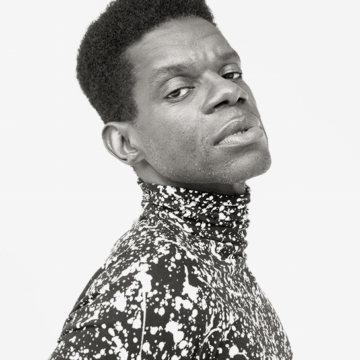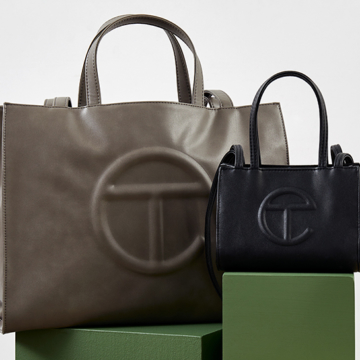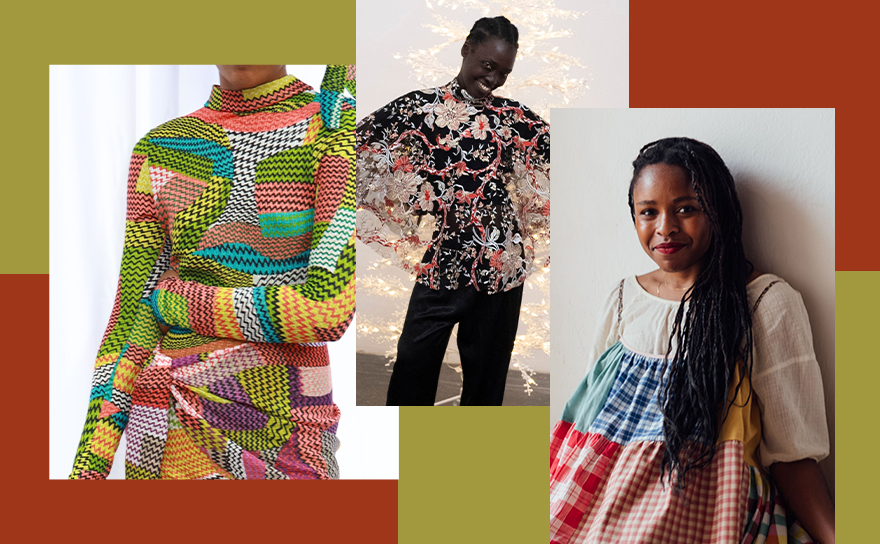
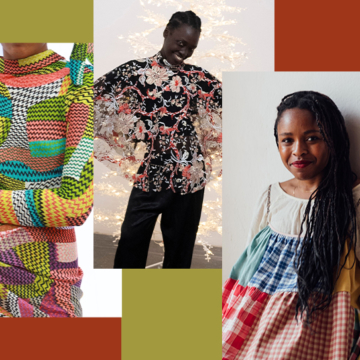
3 Brands’ Upcycled Collections Turn TRR Pieces & Vintage Into Serious Fashion
With fashion month in the midst of its second season upended by Covid, designers are faced with more questions than ever about the value of what they create. As we’ve collectively zoomed out to re-evaluate the fashion landscape (on Zoom, of course), the common takeaway is that things must never go back to the way they were: unrelenting newness, excess and more, more, more.
Using vintage garments, deadstock fabric, discarded scraps and pieces from TRR, designers Hillary Taymour of Collina Strada, Sarah Nsikaka of La Réunion and Tara Subkoff of Imitation of Christ are using what’s old to take fashion in a new, more sustainable direction. They may be meeting the demands of the current moment, but upcycling is an approach they have built into their brands from the very start. This season, doing more with less inspired each of them to create something positive in a time marked by collective grief. The resulting designs recognize what’s at stake, but transcend gloom and doom with pieces that range from embellished sweatpants to colorful, can’t-wait-for-spring patchwork dresses. You can shop the F/W 2021 La Réunion and IOC collections now, exclusively on TRR. Collina Strada fans are in luck with an archive sale while you wait for F/W 2021 to arrive on the site this fall. We caught up with the designers to talk inspiration, how they source materials and what excites them about helming a fashion brand right now.
Sarah Nsikak, Founder, La Réunion
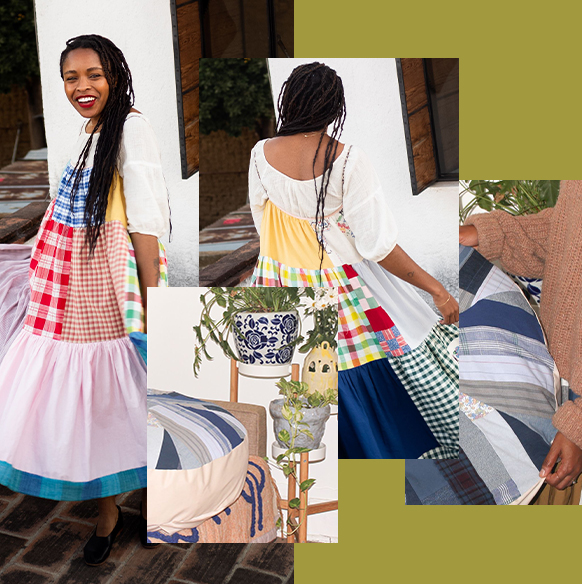
When NYC was hard-hit by Covid, Nsikak asked herself, “What can I make that will make me feel good in a time where that seems impossible?” She found the answer in a capsule collection of hand-crafted patchwork dresses, separates and quilted poufs created from textile scraps. Creating them was a slow, thoughtful process that Nsikak imbued with intention and a personal connection to her craft. “The goal has always been to share Africa-inspired artwork and to do so sustainably. I wanted to be very intentional about introducing clothing into the project, because there are so many brands out there and I didn’t want to do it just because I knew how or because it was expected of me.” Nsikak honed her skills under the encouraging eye of her grandmother, “a seamstress in her Nigerian village [who was] a very skilled sewist.” Each piece can take over an hour to design and two to three hours to sew, on top of the time it takes to source materials and edit ideas. It’s a slow, steady, sustainable approach that just might make the impossible feel possible.
What do you think about the rise of upcycling?
I think it’s the inevitable direction that the fashion industry has to go in. There has been so much damage done by the four season fashion calendar, and it’s time for the big brands to be given accountability to do things more thoughtfully.
What do you look for when sourcing materials? Are there any items that are too precious to upcycle?
I spend a lot of time sourcing and being intentional about using remnants. My friend and sole teammate on this project, Chloe Guss, found out about what I was doing and was really excited to introduce me to some NYC cutting rooms. There is so much textile waste just sitting in these cutting rooms and at many of the factories. They throw it all away, which is devastating to me. Textile waste is one of the largest contributors to carbon emissions. It also negatively affects black and brown countries before anywhere else. I recently read about a 30ft mountain of textile waste rotting in beautiful Ghana. We would never allow this in America or any predominantly white countries – the countries of black and brown people are treated as dump sites for exorbitant American waste. I want to spread the awareness of this as much as I can because it’s the consumption of cheaply made fast fashion that perpetuates these disparities.
To me, if something is being used and serving a purpose, no matter what the monetary value is, it’s probably too precious to upcycle. The issue we have is that there is so much being consumed and created that there’s no way for everything to be utilized in the way that was intended by the maker.
Could these pieces have third and fourth lives and be upcycled again and again?
Of course! They could be used to make anything from blankets to table cloths to tote bags. The loop is never ending if we give it the chance to be.
What excites you about having a fashion brand right now?
Rethinking the way fashion has been for too long and bringing a new point of view that honors Africa.
What’s one thing you’re looking forward to this spring?
Warmth and optimism. I always feel like Spring brings those feelings, but this year it will be even more anticipated being on the heels of 2020. Also I’m really excited to work on more art pieces in Spring and to expand my practice. It is really regenerative work for me and I look forward to carving out more time for it.
Tara Subkoff, Founder, Imitation of Christ
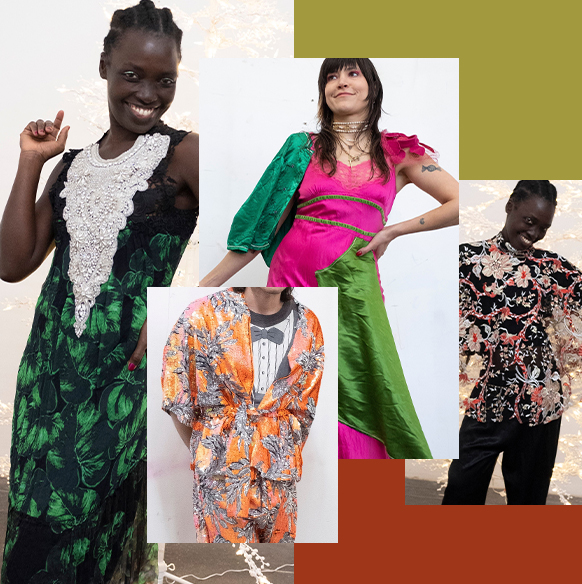
For Subkoff, the multi-hyphenate creator behind design collective Imitation of Christ (and an originator of runway upcycling), this season was especially personal. Coming off of a “painful and scary” bout with Covid and grieving the death of a dear friend, all amidst a larger anxiety about healing the planet, Subkoff was inspired to respond with urgency, but also levity. “This latest fall/winter 21 collection is about ‘celebration,’ even under times of extreme duress,” she said. “The collection is a mixture of both … the beauty in the darkness. The complexity of trying to appreciate these moments even while we are having such a hard time.” It’s a juxtaposition taken to visual extremes in a video presentation featuring an anatomical heart pulsating behind a cast of cool-kid models reveling in IOC’s exuberant, upcycled designs. It might remind us of the limited number of beats we all have, but it also bursts forth with flowers, providing the backdrop for the joy inherent in experimenting with fashion, especially when it’s created with extending the life of the planet in mind.
How do you create as a collaborative? Do multiple people contribute to each piece?
Sometimes. There is never a straightforward “process” as it’s always evolving and changing. Sometimes one artist will work on a piece and then someone else will draw or silk screen on it. Sometimes it will be only one person. Sometimes I will end up adding something to it … sewing on a cross or a piece of jewelry last-minute.
What do you look for when sourcing materials?
I look for what there is a lot of and what looks good to me for the time we are in right now. For instance everyone throws away old sweatshirts and sweats, and it also seems to be all that everyone is wearing these days while being in lockdown and quarantine and working from home. I wanted to add some fun to this and use workout and leisure as the base to add some glamour and some celebration to this. So a lot of beading and deadstock elaborate appliqué went into this. I love this collection! I wanted to keep every piece.
Are there any items that are too precious to upcycle?
I don’t usually upcycle a real classic designer piece that is intact and not damaged. To me these are art works and have a right to be upcycled as they are intact. If there is a designer piece that is damaged, then I love to work with these as they are crying out to be helped and used again. I love doing just little touches to these pieces and expanding on the beauty that they once had.
What excites you about having a fashion brand right now?
I’m excited about creating a brand that is totally upcycled and green. I want it to have no impact on the planet and to have other young people copy this. It’s the best contribution I can leave to help heal this planet and to pass this knowledge on to my daughter, and all younger kids who have this enormous challenge of how to try to heal this. I remember hearing Al Gore speak at a tech conference four years ago and he said it so well: “Calling all entrepreneurs! You have to figure out a business where people can make money by saving the environment.” That’s why I love the RealReal. You guys did it! And now it’s time to think of more ways in which this is possible .
Hillary Taymour, Founder & Designer, Collina Strada
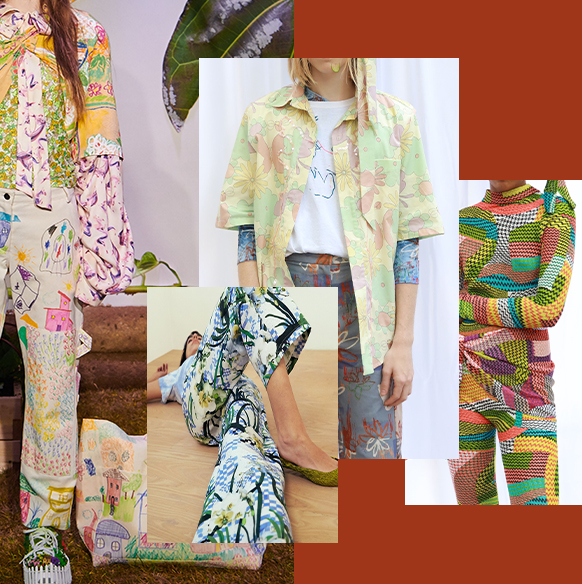
Taymour echoed the tension between the desire to reckon with our current reality and the urge to create something new: “[Upcycling is] important because now, as a designer, it feels selfish to create new garments, but we must create during this time. Upcycling is the perfect way to continue the Collina Strada platform.” This season’s presentation continued the trippy theme of the line’s last outing — a mind-bending video with the theme ‘Change is Cute’ — and was, like some of the pieces used to create it, vintage. Taymour and team revived ’90s-era Animorph illustrations, showing models layered in earth tones, acid-bright colors and bold prints transforming into kittens, snails and flying racoons. After all, if old garments can transform into something new, why can’t Ruby Aldridge transform into snake-hairless cat hybrid?
What do you look for when sourcing materials? Are there any items that are too precious to upcycle?
I always look for color and prints when sourcing for materials, anything that looks fun. Vintage designer items or anything that holds value emotionally sometimes is too difficult to part with.
Could these pieces have third and fourth lives and be upcycled again and again?
Each piece is different, but hopefully will continue to have many, many lives after it leaves my hands.
Do you think more fashion brands are upcycling materials than they were a few years ago? What do you think about the rise of upcycling?
It’s definitely happening more and more, and it’s a great thing to watch. I’m happy to see designers taking it seriously and incorporating it into their process.
Tell us about one of your favorite pieces in the collection – how was it made? Who do you imagine wearing it?
I love the purple top that Ruby Aldridge [wears] that is made from the top of an Escada gown. I’m really in love with the beading and I dream of her wearing it to a party when this is all over.


